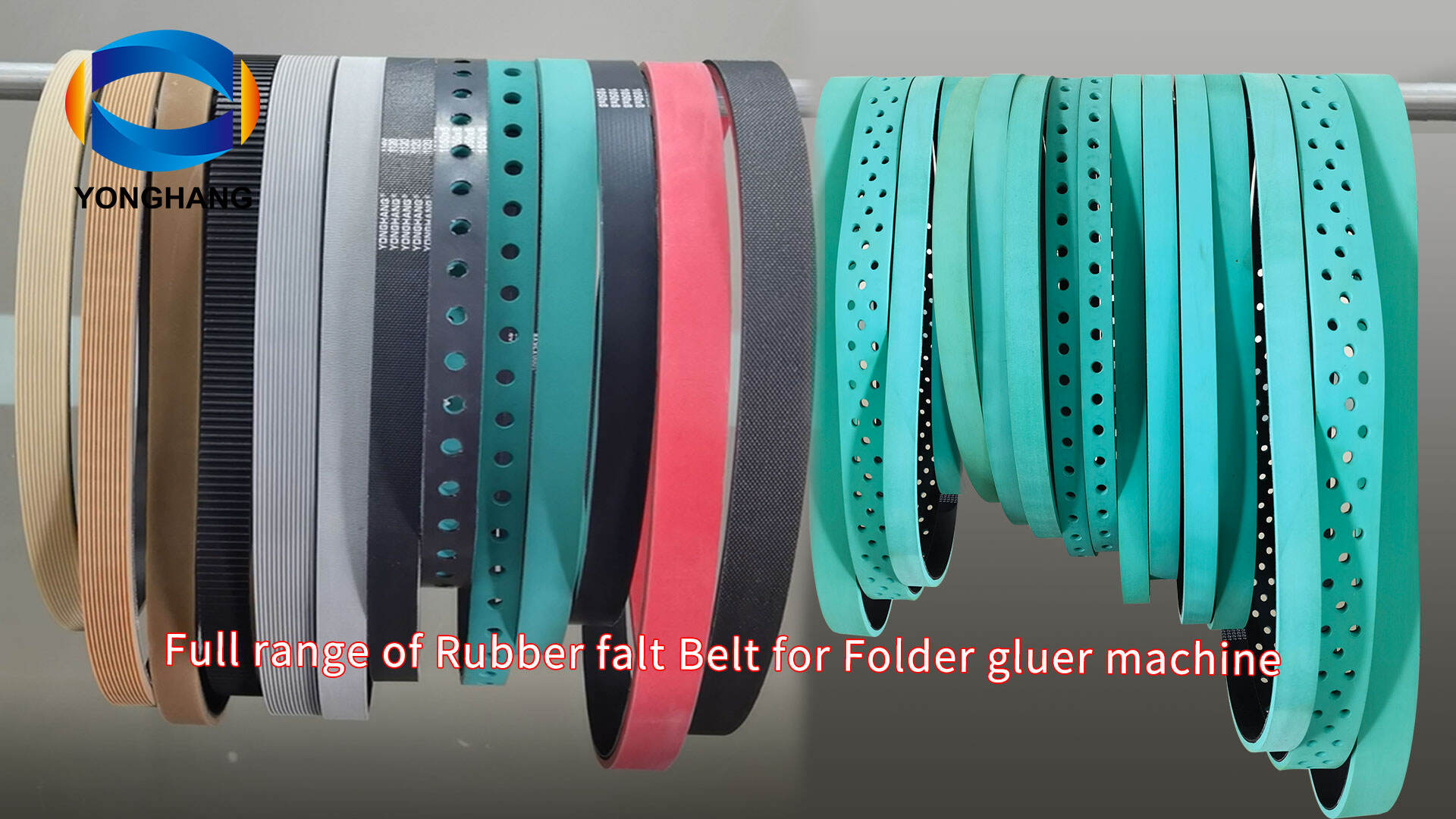How Folder Gluer Belts Influence Glue Joint Accuracy
Impact of Belt Quality on Glue Joint Consistency and Strength
The quality of folder gluer belts really matters when it comes to getting those reliable glue joints every time. According to Packaging Trends Report from last year, problems with belt materials or wear can actually lead to around 37% differences in how strong the bonds end up being. Polymer belts engineered specifically for this work beat regular rubber ones hands down. They fail much less often at sticking things together because they don't soak up as much adhesive and hold their shape better under heat. What's on the surface makes all the difference too. Those micro-grooved belts keep glue application pretty consistent between 0.08 and 0.12 mm thick. Regular or worn belts vary way more, sometimes going from 0.05 to 0.25 mm. That inconsistency directly impacts how well boxes stand up to pressure tests and whether they'll hold together during shipping.
Ensuring Precise Material Positioning During Folding and Gluing
Getting materials positioned just right depends heavily on belt systems that keep lateral movement under 0.5 mm. At folding stations, this ensures registration stays accurate within about ±0.25 mm. Some real world testing happened too. Over twelve months in several pharmaceutical packaging facilities, they found something interesting when they switched to servo controlled alignment systems. The number of cartons with misaligned glue joints dropped dramatically from around 12.1% down to just 2.3%, all across 18 million units produced. How do they get such precise results? Well, it comes down to controlling a few critical factors. First, keeping tension variations below ±5 Newtons per meter makes a big difference. Then there are those edge tracking sensors that can spot even tiny deviations as small as 0.3 mm. And finally, matching feed rates with dynamic speed synchronization so everything runs smoothly within 0.1% tolerance margins.
Balancing Cost Versus ROI: Do High-Performance Belts Reduce Waste?
Although premium folder gluer belts cost 120-180% more than standard options, they deliver significant returns by reducing glue-related waste by 42%, as reported in the Corrugated Industry Analysis 2024. The following table highlights performance differences:
| Characteristic | Standard Belts | High-Performance Belts |
|---|---|---|
| Avg. glue consumption | 23 g/m² | 18 g/m² |
| Material registration | ±1.2 mm | ±0.4 mm |
| Reject rate | 5.8% | 1.1% |
| Lifespan (production hrs) | 1,200 | 3,500 |
Lifecycle analysis shows a breakeven point at 610 operating hours—typically reached within 6–10 weeks for medium-volume operations—after which facilities average $5,200 in monthly savings from reduced downtime and material waste.
Belt Tension, Alignment, and Drive Synchronization for Consistent Performance
The Critical Role of Proper Belt Tension and Alignment in Folder Gluer Systems
Getting belt tension right and keeping everything aligned properly makes all the difference in creating good glue joints. Just a tiny bit off track here matters a lot - we're talking about something as small as 1 mm of pulley misalignment causing belt wear to jump anywhere from 30% to 40%. That kind of inconsistency really messes things up down the line. If belts are too tight, it puts unnecessary strain on motors and bearings. Too loose? Then there's slippage problems that lead to adhesive being applied incorrectly. Fortunately, modern laser alignment equipment helps techs get those measurements spot on, sometimes within less than 0.1 mm tolerance. This becomes especially important when working with coated cardboard where folding has to be precise at the millimeter level for proper results.
Maintaining Drive Synchronization to Prevent Misalignment in Glued Joints
When it comes to packaging machinery, synchronized drive systems are essential for keeping those folding mechanisms in step with where the adhesive gets applied. According to research published last year, around two thirds of all problems with glue application actually stem from out-of-sync servo motors rather than issues with the adhesive itself. Take those dual path folder gluers we see in facilities making intricate box designs - they rely on constant torque checks to keep everything lined up properly across multiple drive points. The newer models come equipped with closed loop feedback systems that tweak motor speeds on the fly, so fold lines stay aligned with glue spots even when production specs change quickly mid-run. This kind of coordination makes a huge difference in reducing waste and improving overall product quality.
Troubleshooting Common Alignment Issues and Their Impact on Output Quality
Three primary alignment issues account for 82% of glue joint defects:
- Angular misalignment: Causes diagonal glue squeeze-out, weakening seam bonds
- Parallel offset: Results in uneven adhesive coverage on overlapping flaps
- Tension asymmetry: Leads to material creep during pressing
Technicians should first verify tension using ultrasonic testers, as research confirms that 45% of apparent alignment problems stem from improper tension. Infrared thermography is increasingly used to detect overheated drive zones, signaling early signs of synchronization drift before failures occur.
Material Compatibility and Design of High-Performance Folder Gluer Belts
Advanced Materials Used in High-Performance Folder Gluer Belts
High performance folder gluer belts rely heavily on engineered polymers and composite materials. Polyurethane stands out as the go to option because it resists chemicals and maintains shape even when stressed during those intense operations running over ten thousand cycles per hour. When manufacturers apply silicone coatings, they see about an 18 percent drop in problems with adhesive curing issues, especially important where temperatures fluctuate compared to regular rubber belts. What makes these belts work so well? They typically feature surfaces that stand up to cardboard fibers without wearing down quickly, cores designed to stretch minimally for around half a millimeter precision, plus special treatments against static electricity which helps keep sheets aligned properly even when humidity levels rise.
Matching Belt Specifications to Cardboard Type, Weight, Thickness, and Coating
Selecting the right belt requires evaluating three key cardboard characteristics:
| Factor | Belt Response Requirement | Performance Impact |
|---|---|---|
| Coating (e.g., UV varnish) | Non-stick surface texture | Prevents adhesive transfer defects |
| Basis weight (>400 gsm) | Increased tensile strength | Eliminates stretch-induced registration errors |
| Recycled fiber content | Enhanced debris clearance grooves | Reduces downtime from material buildup by 32% |
Manufacturers using material-based belt selection protocols report 27% fewer production stops due to glue-related jams. The optimal belt combines a semi-porous surface for controlled adhesive absorption with reinforced edges to handle heavy board stocks without warping—directly improving waste reduction and ROI.
Maintenance Best Practices to Extend Belt Life and Performance
Routine inspection and cleaning procedures for folder gluer belts
Weekly inspections reduce unplanned downtime by 43% compared to monthly checks, according to the Material Handling Institute 2024. During production pauses, technicians should examine belts for cracks, edge fraying, and tension inconsistencies. Cleaning should involve compressed air and non-abrasive brushes to remove adhesive residue without damaging sensitive belt materials.
Preventive and predictive maintenance strategies for continuous operation
| Strategy | Impact | Frequency |
|---|---|---|
| Laser alignment verification | Reduces edge wear by 27% | Quarterly |
| Drive pulley lubrication | Extends bearing lifespan by 200+ hours | Every 500 cycles |
| Infrared tension scanning | Prevents overload-related tears | Monthly |
When to replace folder gluer belts: Signs of wear and lifespan expectations
Changing belts before their time actually costs around $18 per square foot in extra operational expenses according to recent studies. On the flip side, waiting too long can lead to problems down the line, with glue joints failing at a rate that jumps over 60% higher than normal (as noted in the Packaging Efficiency Report from 2023). When it comes time to replace those belts, watch out for three main signs: grooves on the surface deeper than about 1.5 millimeters, any permanent stretching where the belt has lost more than 3% of its original thickness, and peeling edges that show up clearly even with just basic inspection tools. Most good quality polyurethane belts should hold up for somewhere between 18 and 24 months in facilities running three shifts daily, provided regular maintenance checks are performed and proper cleaning protocols followed consistently.
Smart Monitoring and IoT Technologies for Real-Time Belt Performance
Modern folder gluer systems leverage IoT-enabled monitoring to achieve unprecedented precision, with 83% of packaging manufacturers reporting improved glue joint accuracy after adoption (Industrial Automation Report 2024). Real-time data collection eliminates reactive maintenance and optimizes production stability.
Integrating Smart Sensors for Real-Time Tracking of Belt Position and Tension
Sensors built right into the equipment can spot really tiny misalignments and changes in tension that go past plus or minus 5 percent. These sensors send all this information to smart algorithms which actually fix problems even before they become real issues. Studies indicate these systems cut down on wasted materials somewhere around 12 to maybe even 18 percent when running at high speeds for folding operations. Some of the top manufacturers are putting RFID chips directly onto conveyor belts now. These chips talk about how much wear and tear is happening to central monitoring screens, so operators can make necessary tweaks while everything is still running live on the factory floor.
Key Performance Indicators: Glue Accuracy, Waste Reduction, and Production Efficiency
IoT systems focus on three measurable outcomes:
- Glue application consistency maintained within ±0.1 mm tolerance
- Substrate waste rates tracked per 1,000 units produced
- OEE (Overall Equipment Effectiveness) gains from reduced unplanned downtime
A 2023 Market Data Forecast analysis found that facilities using smart monitoring achieved 22% faster changeover times between jobs, increasing daily output capacity without sacrificing joint integrity.
Frequently Asked Questions
What are the benefits of using high-performance folder gluer belts over standard ones?
High-performance folder gluer belts offer lower average glue consumption, improved material registration, lower reject rates, and a longer lifespan, making them more cost-effective in the long run despite the higher initial cost.
How does proper belt tension affect the performance of folder gluer systems?
Proper belt tension is crucial for preventing wear and ensuring consistent glue application. Misalignment due to incorrect tension can lead to increased wear and operational inconsistencies.
What should I look for to know when it's time to replace folder gluer belts?
Look for grooves deeper than 1.5 mm, permanent stretching beyond 3% of original thickness, and peeling edges. Replacing belts proactively can prevent higher failure rates of glue joints.
How do smart monitoring and IoT technologies improve glue joint accuracy?
IoT technologies allow for real-time tracking and adjustments, ensuring glue application consistency within tight tolerances and reducing material waste and downtime.
Table of Contents
- How Folder Gluer Belts Influence Glue Joint Accuracy
- Belt Tension, Alignment, and Drive Synchronization for Consistent Performance
- Material Compatibility and Design of High-Performance Folder Gluer Belts
- Maintenance Best Practices to Extend Belt Life and Performance
- Smart Monitoring and IoT Technologies for Real-Time Belt Performance
-
Frequently Asked Questions
- What are the benefits of using high-performance folder gluer belts over standard ones?
- How does proper belt tension affect the performance of folder gluer systems?
- What should I look for to know when it's time to replace folder gluer belts?
- How do smart monitoring and IoT technologies improve glue joint accuracy?

 EN
EN
 AR
AR
 HR
HR
 DA
DA
 NL
NL
 FR
FR
 DE
DE
 EL
EL
 HI
HI
 IT
IT
 JA
JA
 KO
KO
 NO
NO
 PL
PL
 PT
PT
 RO
RO
 RU
RU
 ES
ES
 TL
TL
 IW
IW
 ID
ID
 SR
SR
 SK
SK
 UK
UK
 VI
VI
 TH
TH
 TR
TR
 AF
AF
 MS
MS
 IS
IS
 HY
HY
 AZ
AZ
 KA
KA
 BN
BN
 LA
LA
 MR
MR
 MY
MY
 KK
KK
 UZ
UZ
 KY
KY
